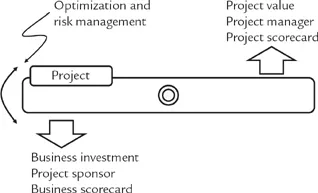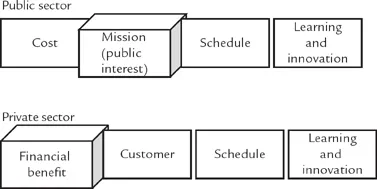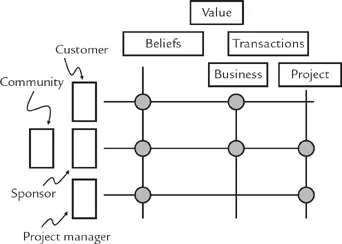![]()
CHAPTER
1
UNDERSTANDING THE VALUE OF PROJECTS
Every individual endeavors to employ his capital so that its produce may be of greatest value. He generally neither intends to promote the public interest, nor knows how much he is promoting it. He intends only his own security, only his own gain.
—Adam Smith
The Wealth of Nations
Let us begin our discussion about the value of projects with this idea: Project value is the worth of a project’s throughput, or the difference in business value measured before and after a project, as earned during the course of the project schedule. Business value is the worth of a project’s throughput applied to business needs, as measured over some business duration. Maximizing project value is really about optimizing and managing the tension between the project manager’s mission to manage for project value and the project sponsor’s charge to enhance business value. Managing the tension between business and project value is tantamount to optimizing project success in the context of business success. Such optimization—actually, the avoidance of suboptimization—is a trade-off of value propositions between and among projects and the business, and is a form of risk management aimed at both project and business objectives, as illustrated in Figure 1-1.
Business value and project value are usually in balance, meaning that the best value outcome of the project is also a best value outcome for the business. But sometimes a specific project is suboptimized for the larger benefit of the business. Thus, in Figure 1-1 risk management and optimization are illustrated as activities that affect the balance of the project with the business. The aim of risk management and optimization is to effect the best overall outcome as valued by the business. Indeed, in portfolio management (to take one example), a specific project is sometimes suboptimized for the larger benefit of the business. Tools have been developed specifically for handling such optimizations. (Another example, to be discussed in Chapter 12, is game theory, which is used to evaluate “what-if?” optimization scenarios among competing strategies.)
The project is optimized for the larger benefit of the business.
Projects are most successful when executives, sponsors, stakeholders, and project managers all share the idea that projects exist only to promote and benefit the organization at large.1
Project success, payoff, or value attainment is measured with several different metrics, some of which inform the project scorecard and others the business scorecard. Both scorecards reflect the biases and beliefs held by all the managers and organizations involved. For instance, in the public sector, mission—representing the public’s interests—usually dominates cost. In the private for-profit sector, financial benefit always dominates, or at least is first among equals. We see these ideas illustrated in Figure 1-2.
Scorecards reflect beliefs and biases.
DEFINING VALUE
On one level, values are what people believe in, a “truth” of sorts that needs no proof; on another level, value expresses a sense of worth, and it is transactional. This chapter will develop two conceptions of value:
1.Value as beliefs
2.Value as worth exchangeable in a transaction.
1.Business value
2.Project value.
One possible set of relationships is shown in the matrix. At each intersection, if there is an interaction (influence) of one side with or on the other, the intersection is shown as a small grey circle. If there is no circle, there is no relationship at an intersection.
Beliefs and value transactions inform projects and business.
In this particular example, the absence of a circle at the intersection of the transactional business with the project manager indicates no direct relationship between the project manager and the transactional value of the business. (Presumably, the project manager goes through the sponsor to reach the business indirectly, but that idea is not shown here.)
Value as beliefs
Value as a personal belief is just there. People hold these beliefs without reservation. No second party is needed; no validation or affirmation is needed. Such beliefs are a moral and ethical code of sorts; collectively, they form culture. Belief values are conveyed in the culture of the community and in the environment of an enterprise, business, or operating entity. Persons living together in a common culture generally share many beliefs. For example, here’s one widely shared belief:
“… that they are endowed by their Creator with certain unalienable rights …”
The effects of leadership on cultural values are hard to understate. In this regard, portfolio managers, program managers, and project managers have a special role to play in developing and applying cultural values in project activities. Project managers are leaders as well as managers. As leaders they influence personal and interpersonal performance; they instill and promote culture. As managers they measure results and effect corrections. Indeed, their qualities of leadership become inextricably entwined with the values that they espouse.
Leadership is either directional—“Follow me; I have the answer”—or rallying: “Here’s the problem; let’s pull together to find the solution.” Each in its own way influences values and doctrines. Possible effects of both kinds of leadership appear in Table 1-1.2
In both the public and private sector, cultural beliefs become doctrine. Doctrine is built from the top down; it reflects the beliefs, attitudes, and strategic policy of the organizational leadership. Consider these examples of beliefs:
•Quality is free.
•There’s no substitute for ethical, honest, and transparent transactions.
•Community partnership is good business.
•Employees are inherently trustworthy.
TABLE 1-1 Leadership System
| Leadership Approach | Influence on Values and Doctrine |
| Directional | Sets direction and standards for culture Imposes doctrine from a position of authority Establishes order and protection |
| Rallying | Negotiates resolution of conflicting values among constituents, maintaining manageable stress in the community Clarifies the values and principles at stake Promotes negotiation, accountability, and personal responsibility to values and principles |
Though generally well-grounded and felt deeply, cultural values and doctrine are nevertheless subject to modification and evolution over time. Ronald A. Heifetz, a leading academic in the field of leadership, writes: “Values are shaped by rubbing against real problems, and people interpret their problems according to the values they hold.”3 To Heifetz’s statement we add: people shape their responses to events and circumstances according to the values they hold. In business, values prescribe ethical and legal performance but also should depend upon the three Rs:
•Respect for individuals, ...











